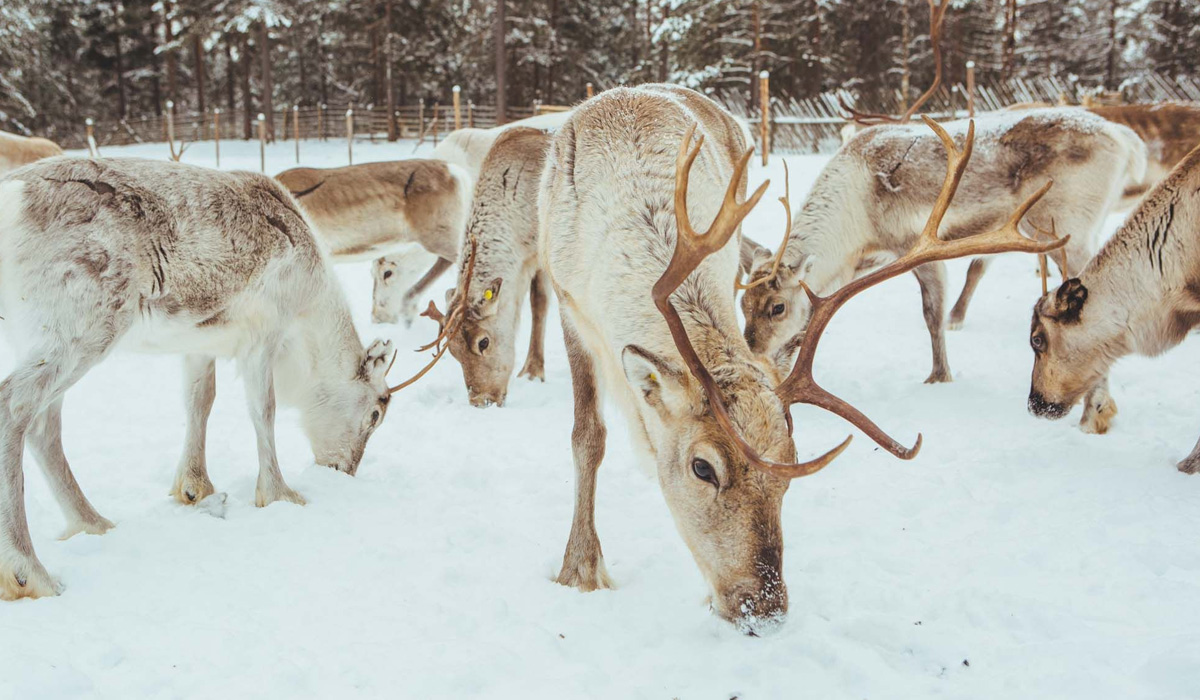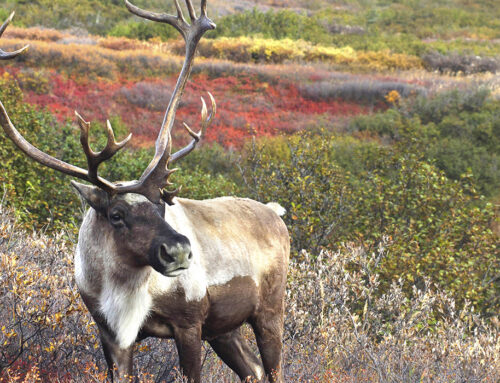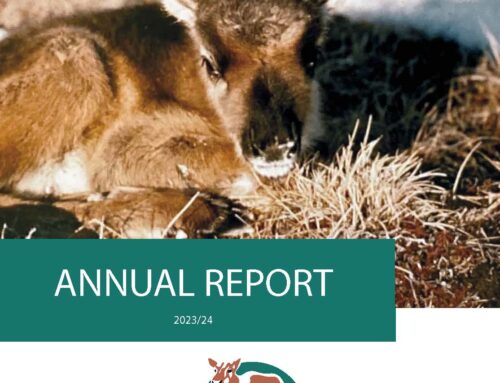CHAIRMAN FINLAND-BOUND THANKS TO NWMB
For BQCMB chairman David Kritterdlik, financial backing from the Nunavut Wildlife Management Board (NWMB) has meant the difference between attending, or not attending, an important international workshop on changes to caribou and reindeer systems throughout the Arctic.
The BQCMB didn’t have enough money to send Kritterdlik to the Feb. 10-14 conference in Rovaniemi, Finland. But conference organizer Gary Kofinas approached the NWMB for assistance, and they quickly pledged $3,000 to underwrite the trip.
Support for the trip was unanimous, said NWMB chairman Ben Kovic. He pointed out board members also figured Kritterdlik’s presence would be beneficial to conference participants from Finland and elsewhere.
“I think David has a lot of documents in his mind that he could use to educate the other group, how he had worked with the BQ board and how beneficial it is for resource users to have such a board.”
“Having one group looking at two herds is a very difficult task,” Kovic stressed. The co-operation of provincial and territorial aboriginal groups eases the challenge, “and reflects that . . . co-management does work.”
The workshop, called “The Human Role in Reindeer/Caribou Systems: Coping with Threats to Environmental Security in Northern Landscapes,” is the world’s first meeting between natural and social scientists and indigenous peoples to look at the role of humans in arctic caribou and reindeer issues. These two animals are undeniably the most important land-based species for people living in the Arctic.
More information about the workshop can be found at its web site (www.dartmouth.edu/~arctic/conf/).
The Finland conference marks Kritterdlik’s first trip outside Canada. “It will be a time to talk to other people from northern parts of the globe,” he anticipated, and to “talk to other people about some management issues. I’m looking forward to it.”
Kritterdlik will take a copy of the BQCMB video, as well as a poster display prepared by important habitats project co-ordinator Leslie Wakelyn (read more about the project here).
UPDATE – Caribou News in Brief will follow up on issues discussed at the Rovaniemi reindeer/caribou workshop in its next issue. In the meantime, photos from the Feb. 10 – 14, 1999 conference appear here courtesy of Gail Osherenko.
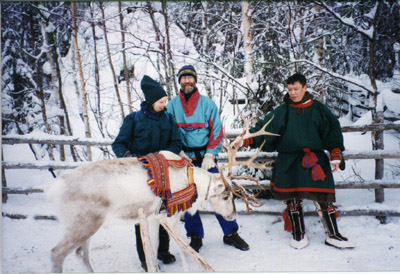
Going my way? Deborah Robinson, Gary Kofinas, one of the workshop’s speakers, and Mikhail Okoteto inspect a brightly festooned reindeer during a trip to a reindeer farm
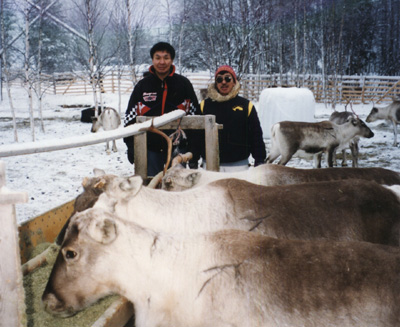
Porcupine Caribou Management Board chairman Joe Tetlichi and BQCMB chairman David Kritterdlik were able to see first-hand the similarities and differences between reindeer in Finland and their barren-ground caribou herds in North America
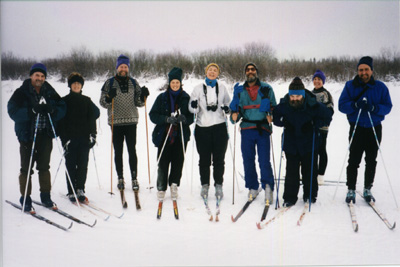
Finland by skis: getting some exercise and fresh air are (left to right) Brad Griffith, Micheline Manseau of Parks Canada, Jack Kruse of the University of Alaska, Deborah Robinson, Allice Legat, Gary Kofinas, Don Russell, Mary Kruse and Curtis Freese
CMB SCHOLARSHIP FUND
University of Alberta student Joseph Dragon nabbed the $2,000 Beverly and Qamanirjuaq Caribou Management Scholarship in 1998. Dragon, who will examine the Southampton Island herd, is studying the commercial use of caribou in the Northwest Territories.
For details about the fund, contact: Association of Canadian Universities for Northern Studies (ACUNS), Suite 405,
17 York St., Ottawa ON K1N 9J7. Tel.: (613) 562-0515, fax: (613) 562-0533.
Web site: www.geog.mcgill.ca/northern/acunshome.html
FIRST NATIONS’ CONCERNS GROW IN COUNTDOWN TO NUNAVUT
Improve spirit of co-operation, BQCMB urges Inuit organzations, by putting Article 40 of Nunavut Land Claims Agreement in place
A court case fighting for Dene hunting rights on traditonal lands that now fall inside Nunavut’s borders gained more attention, and support, when all other First Nations groups whose members live next door to the new territory of Nunavut announced at a Dec. 9, 1998 press conference in Ottawa that the federal government had infringed on their treaty rights too by giving parts of their traditional lands to Nunavut.
The Grand Council of the Crees (Quebec), the Nishnawbe Aski Nation (Ontario), the Dene Nation (Northwest Territories), the Federation of Saskatchewan Indian Nations, the Manitobi Keewatinowi Okimakanak (MKO) and the Assembly of Manitoba Chiefs are now all working together for the first time to protest what they say is a conflict of treaty rights orchestrated by the federal government, which passed the Nunavut Land Claims Agreement Act into law in 1993.
“Because you and your government have taken the position that the rights of First Nations will not be recognized within the proposed territory of Nunavut, Canada has now pitted First Nations and the Inuit against each other as adversaries,” charges Assembly of First Nations national chief Phil Fontaine in a letter to Indian Affairs Minister Jane Stewart.
Joined by Grand Chief Matthew Coon Come of the Grand Council of the Crees, Dene National Chief Bill Erasmus, Chief Ila Bussidor of the Sayisi Dene Nation, Federation of Saskatchewan Indian Nations grand Chief Perry Bellegarde, Assembly of Manitoba Chiefs Grand Chief Rod Bushie, MKO Grand Chief Francis Flett and Grand Chief Charles Fox of the Nishnawbe Aski Nation, Fontaine promised that “between now and April 1, 1999, First Nations will become a presence on Parliament Hill.”
The Samwell Case
In June 1993, Manitoba Chief Simon Samwell took Dene grievances to the Federal Court of Canada. Dene in Lac Brochet, Tadoule Lake, Fond du Lac, Black Lake and Wollaston Lake want the border of Nunavut that runs closest to Manitoba and Saskatchewan moved 200 kilometres northward, out of their traditional hunting grounds. But Anderson says the prime issue in the court case (called the Samwell Case) is the way hunting rights for Dene who hunt on Nunavut ground are defined in Article 40 of the Nunavut Land Claims Agreement (NLCA). According to that wording, they’re not rights, says Anderson – they’re privileges.
The Samwell Case is currently in examination for discovery, an early stage of the legal process.
In February, First Nations will ask Senate to change federal legislation so that the new Nunavut Court of Justice cannot deal with any prosecution against a Dene where they might use issues from the ongoing Samwell Case as a defence. They’ve already urged the House of Commons to change the legislation.
Article 40
Article 40 of the NLCA says, in part, that “notwithstanding any provision of Article 5, the members of the Bands may harvest wildlife for personal, family or community consumption and may trap wildlife within areas of the Nunavut Settlement Area which they have traditionally used and continue to use for those purposes, on a basis equivalent to Inuit under Article 5. Where a total allowable harvest is established for a species that is harvested by members of the Bands and Inuit, the NWMB shall allocate a basic needs level for the Bands, separate from any basic needs level for Inuit, based on available evidence of the Bands’ harvesting of that species inside the Nunavut Settlement Area, taking into account the Bands’ harvesting of that species outside the Nunavut Settlement Area.”
Under earlier treaties negotiated with the federal government, any treaty Indian can hunt for food any time of year, in any quantity. The difference between NWT before April 1, 1999, and the reality of Nunavut afterwards, says Anderson, is that Nunavut’s public government and land claim settlement are intertwined.
“Nunavut is enormously powerful.”
Still, the Samwell Case clearly puts the onus on the federal government to change things.
“The government is steadfast in its refusal to either refer to the Supreme Court (to resolve the dispute), or acknowledge that rights exist,” says Anderson. “There is correspondence from the Inuit that says when there is an acknowledgement either by Canada or a determination by the courts that (treaty) rights apply throughout all of traditional territory north of 60 . . . they will open discussions.”
“They too correctly recognize it’s really Canada’s actions and inactions that have created this circumstance. The Inuit of Nunavut are not in a position to acknowledge rights. Only Canada can do that.”
Laurel Clow of the special claims division of the Department of Indian Affairs and Northern Development said the federal government is unable to comment on the case because it is currently in litigation. She added, however, that Indian Affairs Minister Jane Stewart met with the Sayisi Dene before Christmas, and was considering the matter.
Allay fears – put Article 40 in place, urges BQCMB
For years, the 13-member BQCMB, which brings together Dene and Inuit hunters along with biologists and wildlife managers from Saskatchewan, Manitoba, NWT and Nunavut, has seen the concerns of Dene firsthand. As a co-management board, it’s also worked to overcome regional differences, both within the board and in communities on the range of the Beverly and Qamanirjuaq caribou herds.
In 1985, a meeting was staged with Inuit negotiators in Arviat. In August 1990, elders from Nunavut and northern Manitoba met in Arviat again to talk about concerns over hunting in shared hunting grounds. In February 1998, a group of Athabascan Dene from northern Saskatchewan, led by BQCMB member Jimmy Laban, flew to Rankin Inlet to talk with members of the Kivalliq Inuit Association, the Keewatin Wildlife Federation and the Nunavut Wildlife Management Board.
BQCMB chairman David Kritterdlik spoke about the importance of co-operation between Inuit and Dene at the annual meeting of the Keewatin Wildlife Federation in Chesterfield Inlet in October 1998, and the fact that Article 40, which requires Inuit to work out details of a wildlife management agreement with Dene of northern Manitoba and northern Saskatchewan, had still not been put in place.
Kritterdlik repeated these concerns to officials of Nunavut Tunngavik Incorporated (NTI), who were also at the Chesterfield Inlet meeting. (NTI is responsible for ensuring that promises made in the Nunavut Land Claims Agreement are carried out.) At the meeting of the BQCMB in Fort Smith last November, Kritterdlik said he was to meet again on the issue with NTI president Jose Kusugak, Kivalliq Inuit Association president Paul Kaludjak, and local NWT MLA Kevin O’Brien.
In an interview on CBC Radio in Yellowknife in early December, Kritterdlik also voiced his desire to see the government of Nunavut sign on to the BQCMB. The board’s established links, he stressed, could be valuable to Nunavut.
Nunavut Lands in Dispute
- Offshore islands in eastern Hudson Bay and James Bay (traditionally used by Crees of northern Quebec)
- Akimiski Island, as well as several other islands (traditionally used by First Nations of northern Ontario)
- Lands north of the 60th Parallel (traditionally used by Dene in northern Manitoba, northern Saskatchewan and NWT)
AROUND THE RANGE
Satellite collars win over new supporters
In a departure from long-held beliefs by Athabascan Dene elders that putting satellite collars on caribou is disrespectful to the animal, communities in northern Saskatchewan have now swung squarely behind the idea. At the BQCMB’s meeting in Fort Smith last November, board member Jimmy Laban of Black Lake reported that Athabascan communities would support collars on some Beverly herd caribou for two years, provided they could review the program after that. Northern Saskatchewan hunters wish to help collar the animals.
Directly north, Dene from Lutselk’e have also turned pro-collar, now that they’ve witnessed the use of collars on Bathurst caribou, said Alfred Lockhart of Lutselk’e.
Meanwhile, the Qamanirjuaq herd is going into Year Six of a successful collaring project. Ten cows now wears collars, and satellite tracking systems provide Arviat regional biologist Mitch Campbell with a reading on their locations every five days. Maps of the collared animals’ movements are distributed once a month.
Caribou scarce around communities
The travels of Qamanirjuaq caribou have taken them far from range communities this winter, leaving some settlements without any caribou meat by mid-January.
Caribou did not migrate near Arviat and Whale Cove. Good numbers of caribou have been spotted near Baker Lake, though.
The pickings have been slim for hunters in northern Manitoba too. In January, hunters from Lac Brochet were foced to make a two-hour journey north before finding caribou.
Satellite collar tracking data from the Qamanirjuaq herd showed that by mid-January, two of the animals were 200 kilometres north of the Saskatchewan/NWT border. Eight others were in the far southwest corner of the Keewatin region, near Ennadai Lake.
Students probe for TK
In order to learn as much as possible about caribou, communities on the range and the BQCMB wish to gather traditional knowledge from hunters. This goal is already underway with a $5,000 pilot project based in one community, Tadoule Lake. That knowledge would then be added to the board’s files.
Project co-ordinator Geoff Bussidor will be working with two senior students from Peter Yassie Memorial School, who’ll be expected to interview hunters and retired hunters in Tadoule Lake, record their answers, and draft maps based on that information.
Interviews will probably take place in the first half of February, and the results of the students’ work will be reported to the BQCMB May meeting in Arviat, as well as to Tadoule Lake residents.
Board member Cam Elliott, who proposed the project and briefed students on work requirements in January, was checking to see if the assignment could count as a course credit for the students.
Fellow board member Albert Thorassie, a guidance counsellor at the school, lauds the approach, and has written the board to ask if more funds could be made available to allow more students to be involved.
Such a hands-on project “could get them thinking about being a biologist,” Thorassie
suggests as an example. “We have to go at it from all angles . . . to change some of their education patterns.”
NWT caribou workshop slated for autumn
For a while it seemed to be the victim of terminal rescheduling, but a critical calving ground workshop being hosted by the government of the Northwest Territories has now been set for September or October, 1999, according to NWT’s Department of Resources, Wildlife and Economic Development. However, issues examined will be related only to the Bathurst and Bluenose herds.
“Managing Development Activities on Caribou Calving and Post-Calving Areas” will generally try to figure out how to manage human activities that come with resource exploration, development and tourism, so that the long-term health of the barren-ground and island caribou in the Northwest Territories is protected.
BQCMB chairman David Kritterdlik wrote to Resources, Wildlife and Economic Development minister Stephen Kakfwi in January 1999 to stress the board’s desire to be involved in the NWT’s Protected Areas Strategy, since the board took part in similar discussions with the Manitoba and Saskatchewan governments relating to protected areas in their provinces.
“It is important that the Northwest Territories be aware of transboundary issues such as caribou habitat,” Kakfwi agreed in a written reply. “(My department) is certainly interested in collaborating with the provinces and the government of Nunavut to identify important transboundary areas that may be candidates for protected areas.”
Thinking big
Outfitter and wildlife biologist Alex Hall of Fort Smith has a dream: to build on the Thelon Wildlife Sanctuary and the Queen Maud Migratory Bird Sanctuary in order to create the largest protected area on Earth. The BQCMB has recommended both the governments of Nunavut and the Northwest Territories support the idea, given its caribou management and conservation appeal.
BQCMB meetings
It will be springtime in Arviat for BQCMB members, who will be staging their next meeting shortly after the official inauguration of the new territory of Nunavut. The meeting will run from May 28-30, 1999.
REPORT ON IMPORTANT CARIBOU AREAS COMPLETED
Five hundred copies of a report that sums up the BQCMB’s most intensive work over the past few years were due out in late January.
Protecting Beverly and Qamanirjuaq Caribou and Caribou Range is a 52-page publication that identifies areas of land and water especially important to the Beverly and Qamanirjuaq caribou. Project co-ordinator Leslie Wakelyn drew on hundreds of government records and thousands of mapping files to draw a conclusive picture of the relative sensitivity of caribou to disturbances at different times of the year, on different parts of the range.
The report will be sent to board members, schools, governments, public and government libraries, hunters and trappers organizations and band councils on the Beverly/Qamanirjuaq range, industry, and agencies responsible for land use planning, resource management and environmental assessment. Two thousand copies of a small fold-out brochure, showing a summary map of the range, will be printed later this spring, to be sent out to the same groups.
The Protecting Beverly and Qamanirjuaq Caribou and Caribou Range report includes 13 black and white maps, and will also soon be available on the Internet at the BQCMB’s web site (www.arctic-caribou.com)
Putting together all the pieces of the caribou mapping puzzle presented Wakelyn with a picture she wasn’t expecting: apathy. Despite pledges by governments to make the health and management of caribou high priority, Wakelyn points out there is very little information from the 1990s other than satellite monitoring locations for Qamanirjuaq caribou, and “almost no recent information on range use by Beverly caribou.”
More details on CD-ROM
Still, for planning agencies, schools, groups that assisted the important habitats project, and a few others who need even more background information, the marvels of computer technology will be harnessed to place up to 60 maps and details about the hundreds of data files used to create the maps and other information on one slim disk.
The $10,000 venture to produce 100 CD-ROMs is going ahead thanks to a $9,000 commitment by the Nunavut Wildlife Management Board (NWMB).
Educational materials rank highly with the NWMB, says board chairman Ben Kovic, especially “with the CD-ROM becoming an important part of the tools to educate the resource users, and also the management groups such as KWF (Keewatin Wildlife Federation) and other provincial groups.”
What’s more, it’s a tool that the NWMB can use as well to make future regulations, Kovic adds.
“Once it’s documented, it’s more accessible than looking through piles and piles of books for the same answer. If it’s on CD-ROM, it’s more compact, easier to access. . . . You can carry it in your pocket.”
Wakelyn says it’s hoped that the CD-ROMs will be ready by spring.
KRITTERDLIK NEW CHAIRMAN

“There’s always been this bit of conflict between Inuit and aboriginal people in the provinces on the boundary and hunting areas and wildlife management issues. I’d like to get all that straightened out – soon,” he says.
Kritterdlik was voted the BQCMB’s new chairman last year, presiding over his first meeting in Tadoule Lake in May.
He takes over from Jerome Denechezhe, whose other commitments, including being chief of Lac Brochet, have placed greater demands on his time. Denechezhe has been a part of the BQCMB since it was formed in 1982, and remains a board member.
Kritterdlik, a former mayor of Whale Cove, joined the BQCMB in 1987, and has had much experience in wildlife management – he was chairman of the Nunavut Wildlife Management Advisory Board, and served with the Keewatin Wildlife Federation for eight years, both as a board member and its president.
He also spent six years on the board of the Kivalliq Inuit Association, and served for a time on the board of Nunavut Tunngavik Incorporated.
Bas Oosenbrug, who represents government of the Northwest Territories on the BQCMB, remains vice-chairman.
PEOPLE AND CARIBOU
There are a few new faces in the BQCMB extended family these days: Richard Mercredi of Fort Smith has been appointed to represent the Métis Nation, filling the void left when former board member Eddy Powder suffered a severe stroke in October 1996. Mercredi has toiled for the government of the Northwest Territories for close to 28 years, in turns as an electrician, electrical foreman, project officer, regional maintenance officer, and facility manager. Hunting, fishing, trapping and carving keep him busy in his spare time, along with another keen hobby – tracing the Mercredi family tree. Matt Fraser, also of Fort Smith, has been named the alternate member for this seat . . . “We have to really get involved in caribou monitoring around mines,” says August Enzoe, a lifelong resident of Lutselk’e who is now the board member representing the Dene Nation (Northwest Territories) on the BQCMB. The seat had previously been filled by Lawrence Catholique, who left in 1997 to venture into tourism with a caribou hunting camp on Artillery Lake. Enzoe is getting firsthand experience with the mining issue. Enzoe and five others from Lutselk’e are part of a regional committee set up in the wake of the huge new BHP diamond mine at Lac de Gras to monitor caribou and the impacts from mining.
The BQCMB meeting in Fort Smith in November was a time for thanks, and farewells. In addition to Don Thomas’ retirement, board members said a silent goodbye to Department of Indian Affairs and Northern Development (DIAND) staffer Floyd Adlem, a board member since 1989. (Adlem wasn’t there because he had been called to a meeting in Ottawa.) Both DIAND and Environment Canada are leaving the Caribou Management Agreement at the end of March 1999. “I really appreciated my time with the board,” Adlem later reflected. “I felt that it was a true partnership of people whose interests centred on the two caribou herds.” Adlem says he’ll miss his friends on the board; anyone wanting to reach him can e-mail Adlem at adlemf@inac.gc.ca . . . Mounted photos of board members and friends were given to Thomas, Adlem, Jerome Denechezhe, in recognition of his years as BQCMB chairman, Leslie Wakelyn, who has neared completion of the demanding Important Habitats project, and back in Ottawa, Caribou News in Brief editor Marion Soublière. The group also hailed Gunther Abrahamson’s 10th anniversary as BQCMB secretary-treasurer. He received a plaque for his service to the board.
Regional biologist Mitch Campbell has comfortably made the leap from Goose Bay to Arviat, since arriving more than a year ago from the Newfoundland provincial government’s Department of Forest Resources and Agrifoods. It’s not his first time in the Arctic, though. While in university, he studied muskox and their winter food habits at Cambridge Bay in Nunavut’s Kitikmeot Region. Campbell was also the recipient of a Beverly-Qamanirjuaq Caribou Management Scholarship in 1989 . . . Keeping a lookout now for other bright university prospects with the interests of caribou at heart will be BQCMB member Cam Elliott, who has taken over from Don Thomas as chairman of the BQCMB Management Scholarship’s trustees. . . . Gone from board meetings but not forgotten is University of Toronto anthropology student Stella Spak, who had been dropping in on BQCMB get-togethers since 1996 while researching her thesis on crisis-based resource co-management. Spak also spent time in Tadoule Lake and Fond du Lac conducting interviews, and recently attended a meeting of the Gwich’in Renewable Resource Board in Tsiigehtchic, Northwest Territories, to draw comparisons to this claims-based co-management group. Still hard at work on her thesis, which she hopes will be published by the end of 1999, Spak says she is thankful to the BQCMB for having let her participate in meetings. . . . From the analytical mind of Gary Kofinas comes a meticulous thesis on co-management that “should be required reading for all involved in the process,” says BQCMB secretary-treasurer Gunther Abrahamson. “Every chapter provides valuable insights and demonstrates the pitfalls of cross-cultural communication. The problems and situations described practically mirror those encountered by the Beverly and Qamanirjuaq Board.” In 1998, Kofinas earned his PhD in interdisciplinary studies in resource management science from the University of British Columbia. He has done comparative research on the role that communities play in caribou co-management systems in Alaska and Canada. Right now Kofinas is preparing a condensed version of his thesis for the Porcupine Caribou Management Board.
A massive heart attack sent Nunavut Wildlife Management Board (NWMB) executive director Jim Noble of Iqaluit to the Ottawa Heart Institute just before Christmas. “It was almost a tragic moment,” said NWMB chairman Ben Kovic of Noble’s brush with death. “It was very hard, and we were very worried.” Kovic calls Noble one of the most valuable team members “any board could ever have.” No one will be hired to assume the executive director’s position while Noble, who has since returned to Iqaluit, is on the mend, but Kovic says he himself will play a greater role in the office.
Ahhh, freedom. That’s a taste of what BQCMB member Tim Trottier will get when he takes a one-year leave of absence (without pay) from his role as regional biologist with Saskatchewan Environment and Resource Management, starting August 1999. His plans include travel – by plane to the Arctic Winter Games next year in Whitehorse, by plane and canoe to the Beverly winter range close to the treeline in late summer or early fall. And by dogsled. Trottier may also enter the Haines Junction to Kluane Lake dogsled competition in Yukon, a round trip of more than 160 kilometres. Trottier, who was the centre of a canine dispute last year that left him with battered hands, reports there haven’t been any dog fights lately. He’s keeping the seventh dog, the fighter, separated from her enemy on the team. While Trottier is on the move next year, his alternate, Dave Brewster, will sit in for him on the BQCMB.
SO LONG, DON

The recently retired Thomas attended his last BQCMB meeting in Fort Smith in November, where 25 people – among them board members, and a delegation from Lutselk’e led by Chief Florence Catholique – paid tribute to Thomas, and the absent Floyd Adlem, who leaves the board because his employer, DIAND, is pulling out of the Beverly-Qamanirjuaq Caribou Management Agreement at the end of March 1999.
Tributes to Thomas also appear in the report, Protecting Beverly and Qamanirjuaq Caribou and Caribou Range.
Here is one of them:
“Don Thomas has studied caribou for more than 40 years and has been a valued member of the Beverly and Qamanirjuaq Caribou Management Board for the past 10 years. He has consistently demonstrated his respect for Aboriginal values and points of view, and has been committed to involving Aboriginal people in his research. His colleagues on the Board consider the completion of this report to be a tribute to him.”
David Kritterdlik
Chairman
THE WOLF HUNT, ONE YEAR LATER
Almost one year after a damaging front page Globe and Mail article launched misinformed perceptions among southerners and an ill-needed exercise in damage control by the government of the Northwest Territories, it appears likely that the harvest from the commercial wolf hunt in Rennie Lake, NWT will be lower this year because fewer caribou are wintering there.
Caribou are the main prey of wolves and where caribou go, wolves follow. In an unusual trend last year, Bathurst caribou joined Beverly caribou in the Rennie Lake area, hunting grounds that are commonly used by Dene hunters from nearby northern Saskatchewan. The two caribou herds have a combined population of about 636,000. Last year’s harvest of 633 wolves from the Rennie Lake was above average. Throughout the NWT, the annual commercial wolf harvest averages at least 800 to 1,500 animals.
But the movements of satellite-collared Bathurst caribou in late November showed that herd probably wasn’t headed there this winter.
The Globe and Mail coverage, carried over the course of a month in news stories and editorials, was critical of the high harvest level and the fact that hunters used snowmobiles to track wolves. Other media began running the story too.
By mid-August last year, NWT’s Department of Resources, Wildlife and Economic Development (RWED) had received more than 900 letters and e-mail messages decrying the hunt, especially the use of snowmobiles. About 500 of these came from members of Defenders of Wildlife, an American group dedicated to wildlife and habitat protection.
RWED has since stated that although a detailed estimate of wolves in the NWT is not available, the number of wolves harvested will not do damage to the population because there are plenty of their main prey around – caribou – and because wolves have shown they can bounce back from high harvest levels.
Still, RWED will be monitoring the Rennie Lake harvest more closely. To help the NWT, wildlife officers from Saskatchewan’s Department of Natural Resources will continue to pinpoint wolf harvest levels in the NWT by keeping an eye on export permits, and will provide wolf DNA samples from the NWT as requested.
Snowmobiles a must
Snowmobiles can legally be used for hunting or trapping in the NWT. Wildlife legislation specifies, though, that snowmobilers can’t repeatedly “chase weary, harass, or molest wildlife without intending to capture or kill it.”
RWED officials have said that because snowmobiles are so important to northerners, their use most likely won’t be banned for wolf hunting. Instead, officials are asking hunters and community members to tell them what they think are acceptable ways to hunt wolves, as long as that hunting is done in a responsible, humane manner.
There is no alternative but to use snowmobiles, residents from Lutselk’e told RWED staff at a community information meeting in late October. Elders added that they felt hurt by the misinformation they had heard on the radio.
BQCMB member Jimmy Laban of Black Lake asked if a similar workshop could be held in one of the Athabascan communities.
MEETING HELPS STUDENTS GET TO WINNIPEG FAIR
With a fair bit of planning, and lots of hard work from some eager youngsters, 10 students from Peter Yassie Memorial School took a four-day round trip to the Winnipeg Exhibition last June, thanks in part to money they’d made hosting the BQCMB meeting in Tadoule Lake in May 1998.
Since Tadoule Lake has no hotel, BQCMB member Albert Thorassie, a guidance counsellor at the school, and fellow board member Cam Elliott spearheaded efforts to have the board eat, sleep and work at the school. Board members brought sleeping bags; the school’s student council, meanwhile, looked after the food. and cleaning up.
Armed with $3,000 earned for hosting the BQCMB meeting, plus some existing funds and discounts from Calm Air and Grey Goose Bus Line, the students headed off to Winnipeg. Students were chosen not for high grades but based on good habits like punctuality and healthy attitudes towards teachers.
“Really, behavior-wise, they were excellent,” said Thorassie.
“Being a board member, it’s good to see that the kids benefit.”
